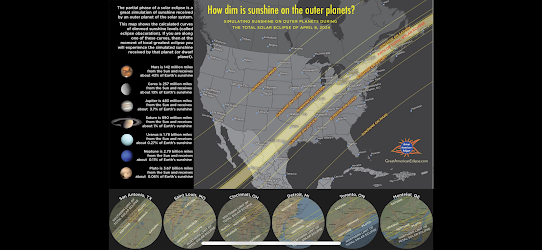Solar Eclipses compared to sunlight on other planets
So one of the most fascinating things about total solar eclipses is not just that the light level drops, it's the way it drops. You may have seen this from some of the videos posted earlier in the blog. It is an absolutely INCREDIBLE experience to witness this!
As the sunlight dims, the light level simulates the amount of sunlight that the Earth would see if it were as far away as the other planets (and other bodies) in our solar system.
If you are in the path of totality, you get to see how much sunlight all the planets (and other bodies) in our solar system beyond Earth receive.
Michael Zeiler of www.greatamericaneclipse.com shared it on his Facebook page:

When the sun is about 60% covered, the sunlight is similar to what the Earth would experience if it were at the distance of Mars (~142 million miles from the Sun).
When the sun is about 96% covered, the sunlight is similar to what the Earth would experience if it were at the distance of Jupiter (~484 million miles from the Sun).
When the sun is about 99% covered, the sunlight is similar to what the Earth would experience if it were at the distance of Saturn (~889 million miles from the Sun).
When the sun is about 99.5% covered, the sunlight is similar to what the Earth would experience if it were at the distance of Uranus (~1.8 billion miles from the Sun).
When the sun is about 99.8% covered, the sunlight is similar to what the Earth would experience if it were at the distance of Neptune (~2.8 billion miles from the Sun)
When the sun is about 99.9% covered, the sunlight is similar to what the Earth would experience if it were at the distance of Pluto (~3.67 billion miles from the Sun).
Consider a quote from Joel Harris, eclipse chaser: “This is the closest experience that anybody alive right now will ever have ….to being on an extraterrestrial planet.”
Think about that this weekend.
Hope it's a great one!
Source for planet distances: https://www.universetoday.com/15462/how-far-are-the-planets-from-the-sun/
Source for Joel Harris interview: https://www.beingintheshadow.com/being-an-eclipse-chaser/

Comments
Post a Comment